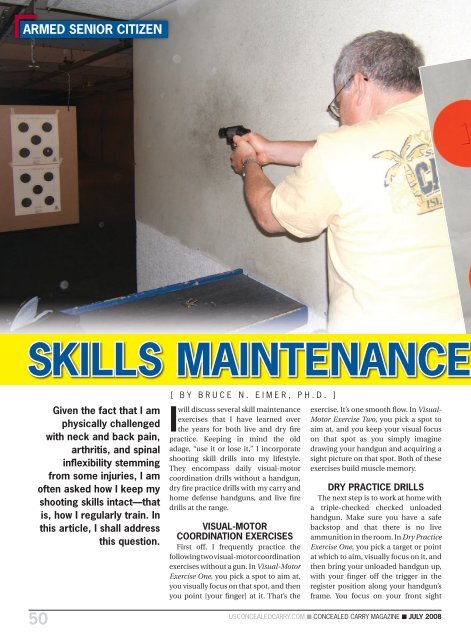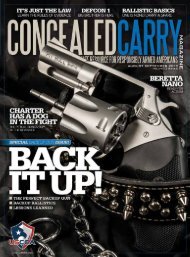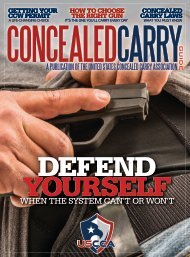Download This Issue - US Concealed Carry
Download This Issue - US Concealed Carry
Download This Issue - US Concealed Carry
Create successful ePaper yourself
Turn your PDF publications into a flip-book with our unique Google optimized e-Paper software.
ARMED SENIOR CITIZEN<br />
Skills Maintenance<br />
Given the fact that I am<br />
physically challenged<br />
with neck and back pain,<br />
arthritis, and spinal<br />
inflexibility stemming<br />
from some injuries, I am<br />
often asked how I keep my<br />
shooting skills intact—that<br />
is, how I regularly train. In<br />
this article, I shall address<br />
this question.<br />
50<br />
[ B Y B R U C E N . E I M E R , P H . D . ]<br />
I<br />
will discuss several skill maintenance<br />
exercises that I have learned over<br />
the years for both live and dry fire<br />
practice. Keeping in mind the old<br />
adage, “use it or lose it,” I incorporate<br />
shooting skill drills into my lifestyle.<br />
They encompass daily visual-motor<br />
coordination drills without a handgun,<br />
dry fire practice drills with my carry and<br />
home defense handguns, and live fire<br />
drills at the range.<br />
Visual-Motor<br />
Coordination Exercises<br />
First off, I frequently practice the<br />
following two visual-motor coordination<br />
exercises without a gun. In Visual-Motor<br />
Exercise One, you pick a spot to aim at,<br />
you visually focus on that spot, and then<br />
you point [your finger] at it. That’s the<br />
exercise. It’s one smooth flow. In Visual-<br />
Motor Exercise Two, you pick a spot to<br />
aim at, and you keep your visual focus<br />
on that spot as you simply imagine<br />
drawing your handgun and acquiring a<br />
sight picture on that spot. Both of these<br />
exercises build muscle memory.<br />
Dry Practice Drills<br />
The next step is to work at home with<br />
a triple-checked checked unloaded<br />
handgun. Make sure you have a safe<br />
backstop and that there is no live<br />
ammunition in the room. In Dry Practice<br />
Exercise One, you pick a target or point<br />
at which to aim, visually focus on it, and<br />
then bring your unloaded handgun up,<br />
with your finger off the trigger in the<br />
register position along your handgun’s<br />
frame. You focus on your front sight<br />
<strong>US</strong>CONCEALEDCARRY.COM n CONCEALED CARRY MAGAZINE n JULY 2008
















